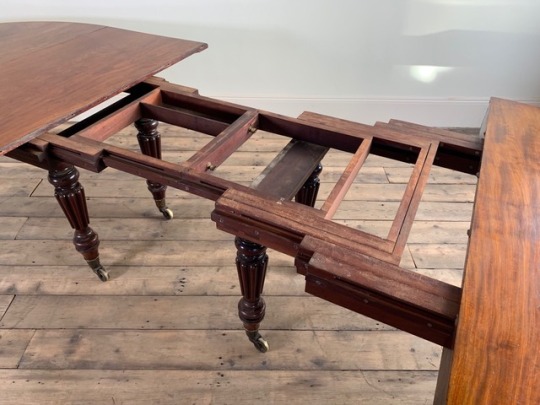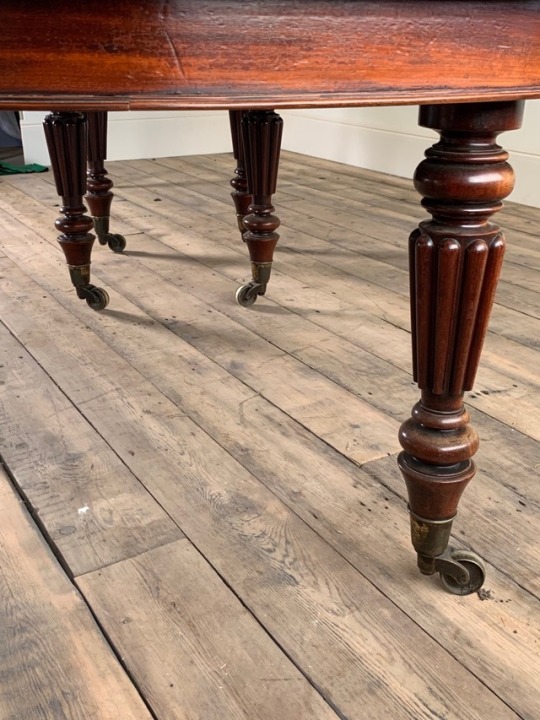#lanchsire
Text




From a earlier post gillows dining table restored now with better photographs,
Every antique furniture enthusiast has heard of the name Gillows, due to the very high standard of craftsmanship and unique design of the pieces of furniture they constructed. Robert Gillow was the founder of Gillows and began cabinet making and finishing furniture from 1731 onwards after he had finished his apprenticeship as a joiner and cabinet maker. He actually became a Freeman of Lancaster in the year 1728 and went into business partnership with George Haresnape. He had two sons who joined him in his business Richard and Robert. These two sons expanded the business to London to where many of the wealthiest buyers lived and this is where the firm quickly got recognized to be one the best cabinet makers of their time. In the 1740s, Gillows chartering ships to import mahogany from the west indies and Jamaica and this is why the timber used was of such good quality as it was old slowly grown solid woods, woods you cannot see in today’s marketplace.
Gillows not only used timbers such as solid mahogany, but unusual veneers and painted designs such as japanning. They often made upholstered chairs, so had their own upholsterers and cabinetmakers.
Amazingly not only did the produce there own fantastic designs but they also used other well known designs such as Chippendale, Sheraton and Hepplewhite. They also were creators of unique furniture like the trou-madame, a ladies version of a billiard table. It invented the extending telescopic dining table, the revolving top library table and secretaire drawers.
The Davenport desk was one of their most famous inventions, a small ladies desk first produced for captain Davenport. Gillows also made linen presses, chest of drawers, small occasional tables all the way to coffins. This lead to them becoming one of the richest families in England of the time.
The firm continued as Gillows until the early 1900s. They had overtime diversified to offer the complete interior design for your home from furniture, metalwork, stained glass, wallpaper, upholstery bespoke pieces including cabinet work for some larger homes, Libraries and offices.
Towards the late Victorian era finances were becoming difficult with the new influx of mass produced furniture and so they joined together with Waring of Liverpool. In 1903 Waring took over Gillows, and the brand Waring & Gillow was borne. They diversifies again into not only quality furniture but also the luxury ships liner market. This went on for quite a few years but it didn’t last long enough as the market place changed again and unfortunately the company went bankrupt. It was then taken over by Maple & Co, to become Maple, Waring and Gillow, three major cabinet makers throughout history joined together from large greatness down to a small firm but it was not to last.
What to look out for when searching for a genuine Gillows piece of furniture.
Unfortunately a very large portion of Gillows furniture was not stamped so you see many pieces associated to Gillows, due to the style, and design. The Gillows stamp can sometimes be seen under table tops, on the top edges of drawers, on the back legs of chairs or sometimes the signature would be written in pencil under drawer linings by the cabinet makers of the firm. You can look in the Gillows books to see the names of cabinet makers to reference with their signatures. The earliest marks were in the form of a printed label ‘Gillow and Taylor’ and this is very rare to find as they would rip or fall off over time. ‘Gillows Lancaster’ stamp was seen from the 1780s up to around the 1850s/60s, when it was changes to ‘Gillow’. In the 1860s, the mark consisted of a capital L, and a serial number with Gillows Lancaster could be seen. Late Victorian pieces produced the stamp ‘Gillow & Co’ and then Waring & Gillow along with a small brass plate. sometimes it can be seen on brass fittings such as locks.
#antique furniture#restoration#antique furniture restoration#antique#furniture restoration#antique restoration#antiques#furniture repair#milton keynes#furniture#gillows#lanchsire#bedfordshire#miltonkeynes
13 notes
·
View notes